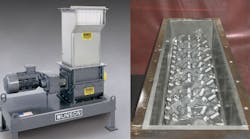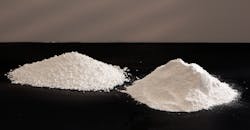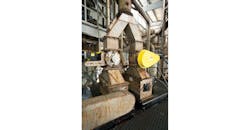The surge in production of North American oil and natural gas has been good for petroleum producers and the businesses that supply them with material for drilling.
One important product in this category is calcium chloride (CaCl2), a two-part chloride salt that provides benefits in such applications as oil well and shale drilling.
It functions as a drilling mud additive by reducing shale swelling, and is used as an additive to oil well completion fluids as it increases density.
CaCl2 aids in cementing of finished wells as it accelerates setting of concrete and adds cure strength. For the same reason it contributes to concrete additives and soil solidification for the construction industry.
A number of industries benefit from CaCl2 properties. For example, its hygroscopic properties help control and suppress dust in road surfacing.
Because it depresses the freezing point of water, it serves as a deicing agent and snow control on roads and pavement.
Demand for CaCl2 is so high among oil producers that supplier Cal-Chlor Corp. of Lafayette, LA, has solidified its standing as the largest distributor of CaCl2 in the world on the strength of oilfield use, says Brett Davis, operations director of the company’s Opelousas, LA, plant.
The plant downsizes CaCl2 pellets into a powder comprising uniformly sized particles using five Screen Classifying Cutters (SCC), provided by Munson Machinery Co., based in Utica, N.Y.
Each cutter processes up to 26,000 lb (11,793 kg) of product per hour.
"They are so important to meeting oilfield on-time demand that Cal-Chlor runs four of them and keeps the fifth for emergency use if one goes offline, Davis says. "The plant’s daily CaCl2 powder production ranges from 200 to 400 tons."
When Davis joined the company in 2006, Cal-Chlor had two SCC cutters which proved successful, prompting the addition of three additional units in Opelousas, La., and the sixth in Ludington, Mich.
Process is automated from railcars to packaging line
Cal-Chlor sources its CaCl2 in Michigan. The salt is refined from natural brines found in underground sandstone formations, and then manufactured and shipped as pellets (about 0.2 in. in diameter) to the Opelousas and Ludington plants for processing.
At the Opelousas plant, loading, conveying and feeding of CaCl2 is automated; no worker handles the calcium chloride prior to bagging, loading and shipping.
The railcars are diverted to a spur where they park over a pit that contains a loader and conveying mechanism. The raw CaCl2 empties into the loader through the bottom of the railcar, and is conveyed to a surge hopper in the plant. The hopper meters CaCl2 pellets to the four of the plant's five SCC-30 cutters through an intake chute at the top of each unit.
Davis says it is important to maintain a constant feed rate. If material backs up it will strain the cutter bearings, causing them to overheat and possibly fail. To assure an even flow of CaCl2 into each cutter, Cal-Chlor installed a mechanical flow control valve with a variable frequency drive above each cutter.
Cutters resist ‘nasty’ effects
Davis points out that the cutters are “near bulletproof” when it comes to processing CaCl2. This toughness is needed due to the nature of CaCl2, which is abrasive, generates heat when collected in large volume, attracts moisture, and generally is a “nasty product” that “does strange things to whatever equipment it comes in contact with.” He notes that as little as 3-4 oz (84-112 gm) of CaCl2 in a cup with water will become too hot to hold in minutes.
In fact CaCl2’s heat-generating and hygroscopic properties become an asset in snow melt and deicing treatments for sidewalks and driveways.
The Opelousas plant operates SCC-30 models, which have 30 in. (76 cm) long feed throats that, like all SCC units, are 11 in. (28 cm) wide. The power range is 20 to 40 hp (15 to 30 kw). Cal-Chlor operates them at between 1,200 to 1,800 rpm.
The units feature a helical rotor design with dozens of cutter tips attached to a helical array of staggered holders called “interconnected parallelograms” to continuously shear oversize materials against twin, stationary bed knives. The cutter tips are aligned along the entire shaft, making total contact with the product. The helical pattern of cutter tips eliminates dead spots and hot spots by moving material throughout the length of the rotor, taking full advantage of the screen area for maximum throughput with minimal fines and little to no heat generation, while ensuring uniform wear.
The cutters are typically made of stainless steel, which in Cal-Chlor’s case is vital to resist abrasion, corrosion and other problems that CaCl2 presents.
Cal-Chlor also operates a sixth SCC-48 model (48 X 11 in., or 122 X 28 cm feed throat) at its plant in Ludington to fill oilfield demand for CaCl2 powder in the Rockies, New York and Pennsylvania.
Powdered CaCl2 bagged, palletized
Powdered CaCl2 exiting the cutters is gravity discharged onto a conveyor and automatically transported to another surge hopper that feeds a bagging station.
At this point workers fill the CaCl2 powder into 50 lb (23 kg) plastic valve bags, palletize them and load them on trucks for shipping.
Davis says valve bags are used because CaCl2 is too oily to effectively seal with conventional plastic bags.
Go to MunsonMachinery.com for more details.












